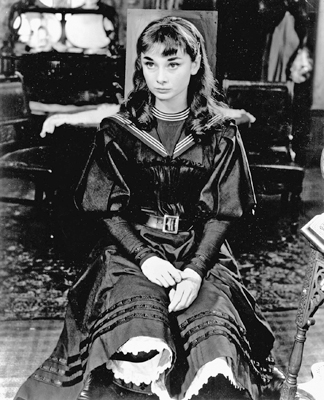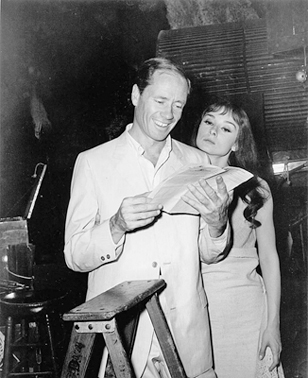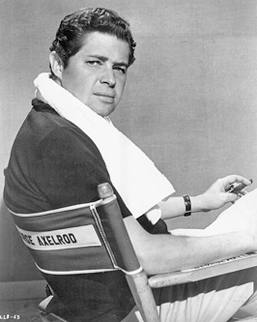Authors: Sam Wasson
Tags: #History, #General, #Performing Arts, #History & Criticism, #Film & Video, #Films; cinema, #Film & Video - General, #Cinema, #Pop Culture, #Film: Book, #Pop Arts, #1929-1993, #Social History, #Film; TV & Radio, #Film & Video - History & Criticism, #Breakfast at Tiffany's (Motion picture), #Hepburn; Audrey, #Film And Society, #Motion Pictures (Specific Aspects), #Women's Studies - History, #History - General History, #Hepburn; Audrey;
Fifth Avenue, 5 A.M.: Audrey Hepburn, Breakfast at Tiffany's, and the Dawn of the Modern Woman (14 page)


Audrey Hepburn, age twenty-two,
onstage as Gigi.

The redoubtable Edith Head in a publicity portrait staged to her exacting taste.

Billy Wilder, Audrey, and Hubert de Givenchy review the designer's sketches for
Love in the Afternoon
.

Humphrey Bogart, Audrey, and Billy Wilder between takes on the set of
Sabrina
. The black cocktail dress is the very one she picked up from Givenchy's studio in the summer of 1953.

The Ferrers, 1959.

Truman Capote in a publicity photo taken for the publication of
Breakfast at Tiffany's
.

George Axelrod, breast man.

Producer Richard Shepherd, sitting in the middle of Fifth Avenue on the first day of filming
Breakfast at Tiffany's
, October 2, 1960.

The Director.

Just after lunch on the first day of shooting, Blake Edwards resumes production on the northeast corner of Fifty-second and Park.

An uncharacteristically pleasant off-camera moment between Patricia Neal and George Peppard.

Edwards, Audrey, and her terrier Famous, outside Holly's brownstone on East Seventy-first.

Someone brought in a little table set with breakfast, and she was told to sit down beside it. The long cigarette holder they kept on a prop table was brought over to her. She thanked them, and a bulb flashed. “Audrey, turn back over your shoulder!” How much more of this? “Yes, like that.” “Now pick up the Danish!” “Good! Fabulous!” She was good at being fabulous.
THE DIAMOND IN THE SKY
Director of photography Franz Planer surveyed the interior. Scattered around Tiffany's he counted a number of genuine store clerks, as well as an equal number of professional extras dropped in to appease the union. They all walked slowly so as not to trip on one of the heavy, interlocking cables curled on the floor like giant strands of black spaghetti. The gaffer did his best to hide them under carpets and behind cabinets, but a certain amount of protrusion was inevitable.
It was impossible to foresee all that could go wrong. There was weather, illness, second thoughts, and at least a dozen egos to contend with. When one of these elements came into contact with another, something had to give. That forfeitâa piece of scenery, a shard of lightâwhich had most likely been
the product of some high-paid specialist's labor and ingenuity, would take a toll on their spirit. It could even disenfranchise them from the production altogether.
But Planer could roll with the punches. He had been shooting since the early years of the centuryâover a hundred and fifty films by the time he got to
Tiffany's
âbut he got the job because he was beyond question the world authority on how to light Audrey Hepburn.
Roman Holiday, The Nun's Story,
and
The Unforgiven
were all his, though, ironically, he took pains to avoid working with major stars. Planer didn't want to be typecast a glamour photographer. He favored instead more of a poetic realism, one that, as
Tiffany's
opening shots attest, combined documentary and stylization in gentle, veiled proportions. He was an empirical artist, a hybrid physicist and painter, and his Oscar nominations for
Roman Holiday
and
The Nun's Story
only further the point: Planer could balance romance and reality. He could shoot the soundstages and the streets.
Because the sun itself looked bluish on Technicolor film, Planer had Tiffany's windows and revolving glass doors gilded in yellow filters and directed his gaffer to direct his electricians to set up thirty-two spotlights with yellowish gels throughout the interior. As always, he was fighting time, natural light, fire code regulations, as well as the restrictions placed on him by the location. It made setting up the shotâdeciding exactly where those thirty-two spotlights were to stand, the precise angle at which they were to be turned, and the intensity of the lightâa matter of epic complexity. And it took time. A long time. The room's natural brightness altered as the hours passed, and with the change in ambient light came the necessary renegotiations, which required more
conversation, manpower, and ultimately time. While they figured out their next move, the earth continued to rotate, and the light changed again.
The pressures were enormous. Aesthetics aside, if the shot looked wrong, if it was too dark or too bright or too red, everything that went into it would be undone. All people would see was the error, and it would be Planer's error, and then what would they do? Reshoot? But did they have time? How much were they over budget? Planer would ask Blake who would ask Shepherd who'd ask Jurow who turned to Marty Rackin who conferred with Frank Freeman who asked to see the rushes and have the plan for reshoots explained to him so he could assess the financial consequences before he made his decision. If in the end the executives said no, Franz Planer would be furious. The shot! What about the shot? He'd turn to Blake. Was everyone against him? No, Blake would assure him. Everyone was against everyone.
ACTION!
Audrey was barely cognizant of the bustle around her. Blake and Planer were in the corner pointing at the ceiling, Shepherd was glad-handing Walter Hoving, and armed guards numbering into the dozens were stationed throughout the store, keeping their eyes on the extras (and the jewels). But Audrey's uneasiness, which had mounted steadily through the publicity shoot, had only grown in these moments before they shot her first scene inside the store. With several faulty run-throughs of the first scene behind them (Audrey had been stifled by the hurried pace of the dialogue), Blake finally called
quiet. He could have continued rehearsing until he felt she was absolutely ready, but the day had been long already and he didn't want to wear her out. Now was the right time. They would try it for the camera. Just the wide shots, though. The close-ups would be shot weeks later, on the soundstage at Paramount.
Blake asked Audrey if she was ready to go. She said she was. The trick, as Edwards was beginning to realize, was to catch her at just the right momentâafter she warmed to it and before diminishing returns. Blake had to find that sweet spot and harness it.
Audrey stubbed out her cigarette and took her place beside George Peppard. She didn't know him well, but already she could tell he thought more of himself than she did of him. Someone must have told him he was the star of the picture.
“Quiet!”
Audrey braced herself, concentrating.
All was silent.
Blake called action. She began, “Isn't it wonderful⦔ when a scream came from off camera.
Audrey, Blake, and the two dozen others looked up.
“Cut!”
Planer was on the floor. An untethered length of cable had dealt him a 220-volt shock. In the end he would be fine, but the shock sent a booming ripple through the entire set. Repairs, insurance, and the standard legalities would mean further delays, which would mean more stress for everyone from the production assistants to Audrey Hepburn.
After everything settled down, Blake weighed his options. It was getting late, they still had a Park Avenue location ahead
of them, and he had a headache. What time was it? An unconscious weighing of the producers' money against the actors' emotion split his headache in two. He would have to keep everyone happy until he got the all clear. Now his headache had a headache. Audrey lit a cigarette.
“Okay, everybody,” announced the assistant director, “here we go again⦔
Cigarette extinguished. The wardrobe supervisor brushed a fleck from Audrey's orange coat. A makeup girl appeared out of nowhere and lunged at her face with a brush.
“Take your places, please⦔
Audrey got up from her chair. The girl followed her as she rose, dabbing at her cheeks all the way to her mark beside Peppard.
“Thank you,
everyone
⦔
“Ready?” Beat. “Roll camera⦔
The camera operator threw a switch. “Camera rolling⦔
The soundman, his eye on the dials, waited until the camera was running up to ninety feet a minute. “Speed!”
The loader dropped a slate in front of the lens. “Scene 126, take 3,” he murmured, clapped his board, and ducked out of the shot.
“â¦And⦔
There was a pause. Blake surveyed the location and the actors and leaned forward in his chair.
“â¦
Action
!”
Audrey and George started walking.
“Isn't it wonderful?” she said to him. “Do you see what I mean how nothing bad could've happenedâ”
“Cutâresetâone more time, please!”
Something had happened. Sliding in and out those interlocking diamond displays couldn't be easy for the camera operator, especially with the weight of millions of dollars of jewelry hanging over his head. They tried it again.
Upwards of ten takes later, Blake had the scene where he wanted it.
“Lunchtime everyone! Thank you!”
Cue the journalists:
“It's true we've left sex ambiguous in the script,” said Audrey, who had hardly a moment to herself since dawn. “Too many people think of Holly as a tramp, when actually she's just putting on an act for shock effect, because she's very young. Besides, I know Truman Capote very well, and much of what is good and delicate about his writing is his elusiveness.”
“When the cast is right,” remarked Edwards to the
New York Times,
“and the script as brilliant as this one is, I just go on the set and do what comes naturally. Axelrod followed the novel, but he added a plot, a love story, for commercial reasonsâI don't mean for money, but for audience approval. And even Capote is happy about the script. He wrote the producer that we should watch the two-foot cigarette holder and not come too close to
Auntie Mame,
but he thought we had Holly right, and that was the main thing. I couldn't agree more.”
Truman was not happy about the script, and he never came to the set. He was still in Europe, traveling with Jack.
LUNCH
“At about 12:00 that first day we broke for lunch,” recalls Shepherd. “Then we went across town to Park Avenue to shoot the
scene in front of the fountain. By then, it was late enough in the day that crowds had gathered to watch the shooting. The weather was gorgeous, the scene was going great, and about 2:30, Blake said, âThat's it! Wrap!' And I said, âWait a minute! What are you talking about? We still have all day!' I was young, back then, and I wanted to be a hero at Paramount, so I pulled Blake aside and told him to keep shooting. Well, Blake was so pissed off that a producer would say that to him in front of the whole crew. He was
so
mad, but I was sticking to my guns. When we got back to the hotel, my wife said, âBlake wants to see you.' I said, âWell, let him come and see
me
!' Anyway, he came down to the room and was obviously very upset. I said, âWant me to order anything?' He said, âJust coffee.' So I ordered coffee and then he started lambasting me. âDick,' he said, âI know when an actor has done enough for the day. They've been shooting since three in the fucking morning.' And then he said, âNever do that again in front of the whole crew.' As he's saying this, I'm pouring the coffee and listening to him, and Blake starts to laugh. I have no idea what he's laughing at until I look down and see I've poured the whole pot of coffee all over the table. That's how nervous I was!”
NEW YORK
The next week was spent location shooting throughout Manhattan. There was the exterior of Holly's brownstone at 169 East Seventy-first, between Third and Lexington avenues. There was the scene between Doc and Paul outside the bandshell in Central Park; the exterior of the Women's House of Detention on Tenth Street; the steps of the New York Public
Library on Forty-second and Fifth; and the miscellaneous places that would provide the ellipses in the “Things We've Never Done” montage.
L.A.
And that was it for New York. Just one week and they were all relocated to Los Angeles. The rest of the film would be shot at Paramount.
Audrey reportedly arrived with thirty-six pieces of luggage and reunited with Mel and baby Sean. They moved into a house on Coldwater Canyon and began to live as a family once again. Audrey plunged into knitting.
GEORGE PEPPARD, IN METHOD AND MADNESS
When asked if she was a Method actress, Audrey responded, “Of course, all actors have a âmethod' in order to be even vaguely professional. Mine is concentrationâno, first instinct, then concentration.” At a time when “Method acting” was printed with quotes, graduates of New York's Actors Studio were viewed by the old guard as narcissistic acolytes of a system that had turned them from just plain actors into two-bit amateur psychologists. Many of them fell in love with their new rock-star status and jumped on the bandwagon without the skill to stay aboard, but others, like Brando and Montgomery Clift, were powerful enough to transcend the bad-image problem, and with the help of what became the next wave in realism, even reverse it.
Alas, the actor George Peppard was not among them. He
belonged to the Method in attitude only, and on the set of
Breakfast at Tiffany's,
everyoneâincluding George himselfâpaid the price for it. Where Audrey aimed to please, George aimed to pronounce. Where she took direction, he resisted. “I must say there wasn't a human being that Audrey Hepburn didn't have a kind word for,” reports Shepherd, “except George Peppard. She didn't like him at all. She thought he was pompous.” When she wasn't around, he referred to her as “the Happy Nun.”
By the time Edwards's company reached Los Angeles, Peppard's working style had become so bold, and his confidence so firm, that the cast, and even his director, had begun to turn away from him. Even Jurow developed a grudge against Peppard for casting himself as the film's star. But none had it harder than Patricia Neal. “I had done scenes with George at the Actors Studio,” she said, “had a very good time, and I adored him, but years later, when I got
Breakfast at Tiffany's,
something happened. I was thrilled when I heard we were going to be in it together, but it wasn't long until I saw that since I last saw him he had grown so cold and conceited.” George's new way of working perhaps accounted for the change, instilling in him his character's animus toward 2E. When misapplied, the Method has been known to foul up off-screen relations in the name of “I
am
my character,” which would help somewhat to explain Peppard's new demeanor, but his attitude didn't end there. A certain amount of friction came from script disputes, which according to Neal were a part of Peppard's campaign to lasso the spotlight. “He didn't want my character to make his character look bad,” she remembers. “My character was dominant, you know, and before George got to the script, I had a
really excellent part, but he didn't want that, so he fought to have my dialogue cut, cut, cut. Much of it he actually managed to get cut because Blake had no choice but to give in, but luckily he didn't get away with all of it.”
